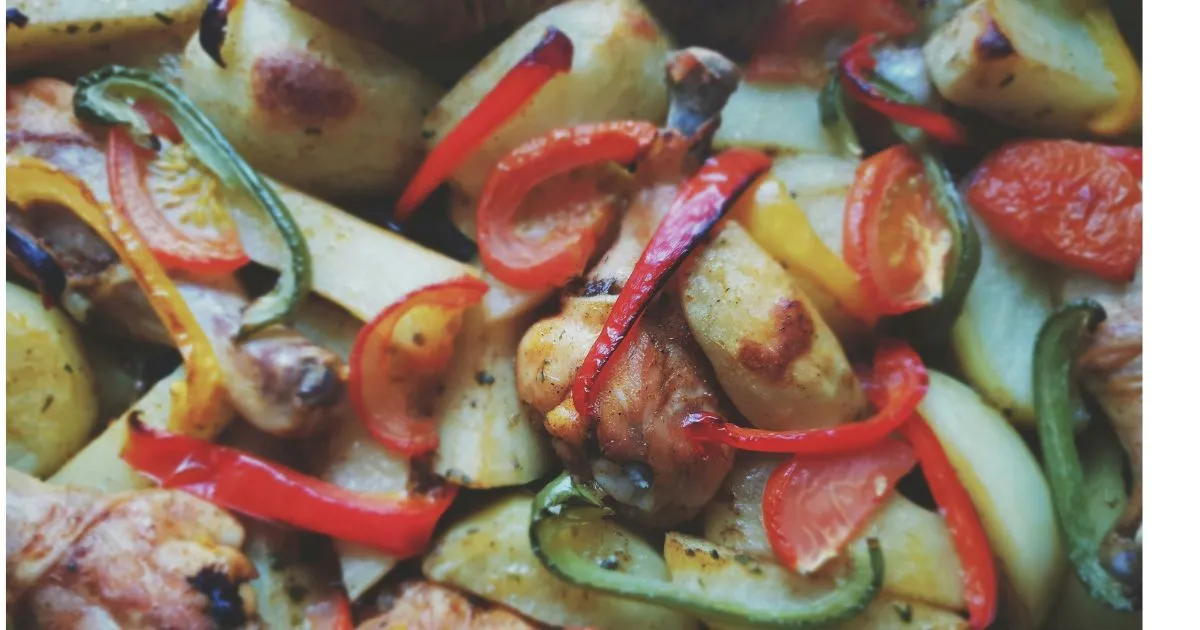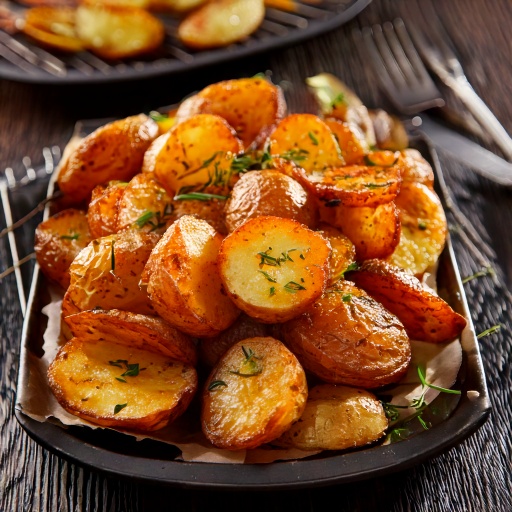Roasting vegetables
- Key Takeaways
- Understanding Caramelization and Maillard Reaction
- Why Air Circulation Matters
- Moisture Content and Its Effect on Texture
- High Heat vs. Low and Slow Methods
- Temperature Adjustments for Different Vegetable Types
- When to Use Convection Settings
- What temperature should I use to roast vegetables?
- How do I prevent my vegetables from burning while roasting?
- Should I oil my vegetables before roasting them?
- What types of vegetables are best for roasting?
- Wondering how to achieve those perfectly crispy edges on your roasted vegetables?
- Do I need to preheat my oven before roasting vegetables?
- What is the Maillard reaction, and why does it matter in roasting?
Roasting vegetables brings out their natural sweetness and rich textures. It turns simple ingredients into complex flavors. Roasted vegetables, whether served as a side or as the main dish, are truly delightful when prepared correctly.
However, many people struggle with issues like charred spots, soggy centers, or bland flavors. These problems keep the full potential of flavor and texture from being realized.
Whether you’re roasting broccoli, carrots, or Brussels sprouts, this guide helps. It breaks down the science and steps to avoid common pitfalls. Discover how to balance temperature, cooking time, and preparation techniques for golden-brown edges and perfectly cooked interiors
These strategies work for any oven, from home kitchens to gourmet setups.
Key Takeaways
- Uniform piece size ensures consistent cooking across all vegetables.
- Proper airflow around the vegetables prevents them from steaming and promotes even browning.
- Oil distribution and pan choice directly affect caramelization and crispiness.
- Monitoring oven temperature avoids overcooking and preserves vegetable integrity.
- Adjusting prep techniques adapts to vegetable density, like thick roots versus delicate greens.
The Science Behind Perfect Roasting Vegetables
Mastering the art of roasting begins with understanding the underlying chemistry. Here’s how science transforms ordinary vegetables into crispy, flavor-packed dishes:
Understanding Caramelization and Maillard Reaction
Caramelization happens when sugars in vegetables like carrots or onions break down at high heat, creating golden-brown edges. The Maillard reaction enhances depth by combining amino acids with sugars, boosting umami flavors. Since both the Maillard reaction and proper browning rely on dry surfaces, always pat your vegetables dry before roasting.
Why Air Circulation Matters
Proper airflow ensures even roast vegetables. Follow these spacing rules:
- Leave ½ inch between pieces on a rimless baking sheet.
- Avoid overcrowding—use two pans if needed.
As the saying goes, “Proper airflow evaporates moisture, turning edges crispier instead of steaming the vegetables.”
Moisture Content and Its Effect on Texture
Vegetables with high water content (zucchini, bell peppers) roast faster than dense roots like potatoes. Adjust time based on moisture:
| Vegetable Type | Moisture Level | Roast Time (minutes) |
| Zucchini | High | 15-20 |
| Brussels sprouts | Medium | 25-30 |
| Sweet potatoes | Low | 35-40 |
Combine this insight with the right oil and seasonings to balance natural sugars and improve texture.
Essential Equipment for Oven-Roasted Vegetables
Mastering oven-roasted vegetables starts with the right tools. The right equipment ensures even cooking and minimizes frustration. Now, let’s outline the essential tools for your kitchen arsenal.
- Rimmed baking sheets: Opt for heavy-gauge aluminum or commercial-grade pans like Lodge or Calphalon. Baking sheets with raised edges prevent spills and allow for proper airflow, which is key for achieving crispy roasted vegetables.
- Avoid deep roasting pans—they trap steam, leading to soggy results.
- Parchment paper, silicone mats, or foil: Parchment keeps veggies from sticking and cleans up easily. Reusable silicone mats cut waste for eco-conscious cooks. Aluminum foil reflects heat, ideal for caramelizing delicate items like mushrooms.
- A sharp knife and a reliable cutting board ensure that vegetables are cut uniformly, which helps them cook evenly.
- Knives make prepping faster. A sturdy board like Endurance Bamboo protects blade edges.
- Stainless steel mixing bowls and spatulas make tossing veggies with oil and spices both efficient and effective.
- Aicone spatula scrapes every last bit of seasoning into the mix.
Quality tools matter, but budget-friendly options exist. Store-brand parchment works as well as name brands. A basic knife set from Walmart suffices for most tasks. Investing in a few key items—like a heavy baking sheet—improves results faster than upgrading everything at once. Proper equipment turns average roasted vegetables into crispy, golden bites every time.
Finding the Ideal Roasting Temperature for Vegetables: Striking the Perfect Balance.
Learning the temperature to roast vegetables is crucial. It helps balance their texture and taste. Decide whether to use high heat for rapid browning or a slower roast for even cooking.
High Heat vs. Low and Slow Methods
High heat (400–450°F) caramelizes sugars quickly but needs careful watching to avoid burning. Lower temps (325–375°F) cook slower but are safer against overcooking. Pick what fits your veggie and how much time you have.
- High heat is excellent for denser vegetables like potatoes or Brussels sprouts, as it creates crispy edges.
- A low and slow approach is best for delicate vegetables such as mushrooms or asparagus.
Temperature Adjustments for Different Vegetable Types
Density affects the best cooking temperature. Here’s a guide for roasting vegetables to perfection:
- Root vegetables (carrots, beets): 400–425°F for 30–40 minutes.
- Cruciferous (broccoli, cauliflower): 400°F for 20–25 minutes.
- Delicate veggies (zucchini, bell peppers): 375–400°F for 15–20 minutes.
When to Use Convection Settings
Convection ovens cook faster by 25%. For example, if a recipe calls for 400°F without convection, use 375°F. This helps avoid burning and ensures even browning.
Prep Techniques
That GuGuaranteesven Roasting
Getting your roast vegetables just right means starting with the right prep. Make sure to cut all vegetables into uniform pieces for consistent results. This ensures they cook evenly. For tender veggies like asparagus, go for smaller pieces. For heartier vegetables like sweet potatoes, larger chunks work better.
- Aim for pieces that are ½- to 1-inch in size to ensure even browning.
- Shred leafy greens (kale, Brussels sprouts) to maximize caramelization.
When coating veggies with oil, toss them in a bowl with 1-2tbsp of ofp oil for every 2 cups of veggies. Make sure to coat them evenly to prevent soggy spots. Choose the right oil for the job:
| Oil | Smoke Point | Best For |
| Extra Virgin Olive Oil | 375°F | Low-temp roasts |
| Grapeseed Oil | 420°F | High-temp browning |
| Avocado Oil | 520°F | Hot blasts for crispiness |
When it comes to salt, timing is everything. Dust vegetables like zucchini and eggplant with salt before roasting to help them retain moisture. But for denser veggies like carrots and beets, wait until after they’re cooked to add salt. For veggies like potatoes or parsnips, boil them for 5 minutes first. This helps them cook faster.
Conclusion: Mastering the Art of Roasted Vegetables
Learning to roast vegetables well begins with knowing about caramelization and how heat spreads. Use proper tools—such as a rimmed baking sheet—and adjust the heat settings according to each vegetable’s needs. This way, you get great results, whether it’s Brussels sprouts at 425°F or carrots at 400°F.
Try new veggies like cauliflower or beets to get better at roasting. Add garlic to broccoli or paprika for extra flavor. Roasting veggies is also good for you because it makes them sweet without using too much oil.
Don’t worry if things don’t turn out right at first. Every try teaches you something new. Start with your favorite veggies and then try others. Perfectly roasted veggies can make any meal special, whether as a side or the main dish.
The secret is finding the right balance of temperature, preparation, and timing. With practice, you’ll learn how to get the most out of every vegetable. So, grab your baking sheet and start experimenting with new flavors today.
FAQ
What temperature should I use to roast vegetables?
Roast vegetables at 400°F to 450°F for the best caramelization and texture. For more delicate vegetables, try roasting them at temperatures between 325°F and 375°F.
How do I prevent my vegetables from burning while roasting?
Cut veggies into even sizes and spread them out on the baking sheet. This helps with air circulation. Keep an eye on them, especially at high temperatures.
Should I oil my vegetables before roasting them?
Yes, oiling your veggies lightly helps with flavor and caramelization. Using just the right amount of oil is essential to prevent sogginess.
What types of vegetables are best for roasting?
Dense vegetables like carrots, potatoes, and Brussels sprouts roast beautifully. In contrast, softer vegetables like zucchini and bell peppers roast more quickly.
Can I roast different types of vegetables together?
Yes, but adjust cooking times. Mix veggies with similar cooking times or cut longer ones into smaller pieces. Add broccoli or cauliflower halfway through.
Wondering how to achieve those perfectly crispy edges on your roasted vegetables?
Arrange the vegetables in a single layer on a baking sheet. Avoid overcrowding. High heat for part of the time can help.
Do I need to preheat my oven before roasting vegetables?
Yes, preheating is crucial. A hot oven ensures your veggies roast well, for great caramelization and texture.
What is the Maillard reaction, and why does it matter in roasting?
The Maillard reaction happens when heat changes food’s proteins and sugars. It creates complex flavors and a brown color. This makes roasted veggies taste better.



